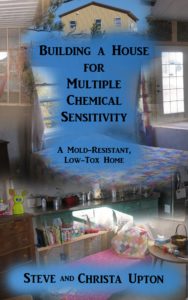So, I would not normally respond to a negative review, but in this case we are talking science, not subjective opinions. People are hurting & suffering from mold/biotoxin illness, & they need to know the true science about mold. Here is the review: https://www.amazon.com/gp/customer-reviews/R2VFAGK4BQX4V2/ref=cm_cr_dp_d_rvw_ttl?ie=UTF8&ASIN=B01LIMV0EI
So, science.
Firstly, Corrine’s house with mold problems that she had to repair had three significant variable differences compared to ours: insulation type, insulation sufficiency, and climate. There may have been other variables as well, such as ventilation/interior humidity, interior wall material, and type of siding. (I think her siding was wood.)
Her insulation that grew mold was denim; mine is wool. These two types of insulation are vastly different. Denim does not easily release moisture; wool does.
In her home tour video, she says that there was not enough insulation in her house, which resulted in very high heating costs. Insufficient insulation is a well-known cause of condensation/moisture problems.
These two variable differences negate the comparison between her house and mine. Therefore it is foolish to draw a relationship & evaluation claiming to have a scientific reason for why our house needs rainscreens or interior vapor barrier.
I feel bad that the insulation in the tiny house failed, but it really doesn’t have anything to do with our experts and research on wall construction.
In addition, the moldy tiny house was in a very humid climate; I live in a dry climate. In the book, several times I mention to the reader they may want to consider a dry climate and/or that what we state in our book may not work in a humid climate. However, if done properly, our house design could work in a more humid climate, I truly believe.
Secondly, Corrine’s statement in general about metal walls needing rainscreens and interior vapor barrier (for cold climates) is far from proven.
Time & time again I have found articles that state that diffusion of warm interior air through walls in the winter is rarely a cause of moisture problems in walls. Some of these articles are referenced in my book.
In fact, “No house in the lower 48 states should require an interior vapor barrier.” http://www.greenbuildingadvisor.com/blogs/dept/qa-spotlight/vapor-barriers-are-good-thing-right The experts I trust insist that interior vapor barriers are almost always a bad idea.
Another article: “Interior vapor barriers are rarely necessary, since wintertime vapor diffusion rarely leads to problems in walls or ceilings. A different phenomenon — summertime vapor diffusion — turns out to be a far more serious matter.” www.greenbuildingadvisor.com/blogs/dept/musings/when-sunshine-drives-moisture-walls Solar vapor drive can be a major problem for houses which have breathable siding in mixed climates where an interior vapor barrier was installed for winter. Regardless of “categorization,” many climates are mixed: needing heat in winter & air conditioning in summer.
According to one article, https://ag.purdue.edu/extension/eden/Mold/Moisture_Problems.pdf with R-11 & R-19 insulation, a winter indoor humidity of 90% would be required to cause diffusion-related condensation problems inside walls. Our wall insulation is R-19 (our attic insulation is around R-38), & our indoor humidity never gets to 90% but possibly for brief moments in the bathroom.
With the information in the above articles, I believe the interior side of the siding will remain dry because not enough diffusion of vapor happens through the wall & insulation in the winter to create significant condensation, normally. I also believe the unique properties of wool insulation give us extra protection.
(3/12/17 update: The walls have indeed stayed dry. See related blog posts for details.)
In conclusion, the use of vapor barriers is extremely controversial, and I prefer to have my vapor barrier not on the inside (where I can control humidity) but rather on the outside (where I cannot control humidity)–the steel siding blocking rain and humidity from entering my walls.
Christa Upton Black Hills Picture Books Edgemont, SD 57735


Christa, I enjoyed reading your response. Because of our prior mold and water intrusion issues, we’ve also learned a lot and enjoy the Green Building Advisor site. You are so right, that there are many, many issues to consider, climate and humidity being major ones. You may already be familiar, but if not, I wanted to share another website that’s been valuable to us.
https://buildingscience.com/documents/digests/bsd-106-understanding-vapor-barriers
Thank you so much. I think the vast amount of variables is also what makes it so hard to study? I have come across this article, but I was just today thinking I need to find the one with this quote: “It is frightening indeed that construction practices can be so dramatically influenced by so little research and reassuring indeed that the inherent robustness of most building assemblies has been able to tolerate such foolishness.” and your article is it!!! 😀 Thank you. 🙂
Glad to be of service!! 😀 We would love to see an overhaul of building practices. People have gotten used to “cheap” and we are paying the price for it. Besides mold and water being such an issue, we watched a video recently about fire. As I bet you already know, modern homes are consumed much faster than old homes are, because of things like particle board, drywall, OSB, etc. — and the chemicals that come from all these burning things is hazardous to ALL, whether they notice it or not.
Yes, me, too (would love to see overhaul of building practices especially cheap stuff)!!! And yes–SO true of chemicals from the burning things. 🙁 You may know already–some people got Toxic Injury/Multiple Chemical Sensitivity from working around the Towers on & after 9-11. 🙁
There are so many variables in building a house of this nature, climate being a major one, as you have stated. There is no perfect plan that ensures a mold free house, but I give you all the credit for putting your information out there to try to save other sufferers some grief. You have put a huge amount of research into this (and sweat and tears too, I’m sure!), and I know your motives are pure. Those who read it should understand that everything has to be customized to their particular needs. You have done a great service here and you should be proud!
Thank you, sweet lady. Exactly–no “perfect plan” can ensure a mold free house. We just try our best. Yes, sweat & tears, too. 🙂 I really, really appreciate your encouragement. Hugs
Pingback: What Would I Do Different With the House? | Black Hills Picture Books